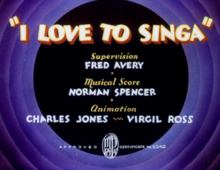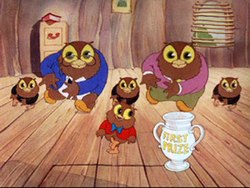I Love to Singa
| I Love to Singa | |
|---|---|
 | |
| Directed by | Tex Avery |
| Produced by | Leon Schlesinger |
| Starring | Tommy Bond Billy Bletcher Bernice Hansen Lou Fulton Tedd Pierce Martha Wentworth |
| Music by | Norman Spencer |
| Animation by | Charles Jones Virgil Ross Robert Clampett |
| Color process | Technicolor |
Production company | |
| Distributed by | Warner Bros. Pictures The Vitaphone Corporation |
Release dates | July 18, 1936 (original release) November 18, 1944 (Blue Ribbon reissue) |
Running time | 8:15 |
| Language | English |
I Love to Singa is a 1936 Warner Bros. Merrie Melodies animated cartoon directed by Tex Avery.[1] The short was released on July 18, 1936.[2]
Plot

I Love to Singa depicts the story of a young owlet who wants to sing jazz, instead of the classical music that his German-accented parents wish him to perform. The plot is a tribute to Al Jolson's film The Jazz Singer.[3]
The young owl [4] is unjustly kicked out of his family's house by his disciplinarian violinist father, Professor Fritz Owl (Billy Bletcher), after he is caught singing jazz instead of "Drink to Me Only with Thine Eyes" to the reed (pump) organ accompaniment of his mother (voiced by Martha Wentworth). While wandering, he comes across a radio amateur contest (clearly a takeoff of the Major Bowes Amateur Hour), hosted by "Jack Bunny" (a pun on Jack Benny and later used in Goofy Groceries, voiced by Tedd Pierce). Billing himself as "Owl Jolson" (a reference to Al Jolson) he wins the contest, but not before his father has finally seen his son's potential and allows him to freely sing jazz. His singing voice is by Johnnie Davis.
Production notes
- The first owlet hatched sang the opening bars of "Chi mi frena in tal momento", from the opera Lucia di Lammermoor. (Papa Fritz compared him to the great opera singer Enrico Caruso.) Translated in Italian is "Who is holding me back at this time?"
- The second owlet to hatch played the beginning of "Träumerei" by Robert Schumann on the violin. (Papa Fritz compared him to the violinist Fritz Kreisler.)
- The third owlet, a flautist, played the first notes of "Spring Song" by Felix Mendelssohn from his work Songs Without Words.
- Owl Jolson is made to sing (badly and off key, due to his loathing of classical music) "Drink to Me Only with Thine Eyes", the lyrics of which are Ben Jonson's 1616 poem "Song. To Celia." Whenever Mama had to pause playing her piano to turn the sheet music page, Jolson managed to get in a few bars of "I Love to Singa".
- The first known reject in the contest played a few bars of "Listen to the Mocking Bird" on the harmonica.
- The blackbird in the blue jacket played a few bars of "Nola", composed by Felix Arndt, on the saxophone.
- The bird with the accordion briefly played "Turkey in the Straw".
- The dark, operatic bird sang a line from the silent film Laugh, Clown, Laugh, even though the lyrics to the theme song don't have those actual words (this version was later used in Yankee Doodle Daffy when Porky Pig opened the door and saw Daffy Duck dressed as the clown singing, then shut the door).[5]
- The overweight bird (voiced by Bernice Hansen) got only a few notes of "I'm Forever Blowing Bubbles" sung before being rejected.
- The country bumpkin bird (voiced by Lou Fulton) stuttered through the first and almost all of the second verse of the nursery rhyme Simple Simon before voluntarily rejecting himself.
Reception and legacy
As with several early Warners cartoons, it is in a sense a music video designed to push a song from the Warners library.
The song in question, "I Love to Singa", was first written by Harold Arlen and E.Y. Harburg for the 1936 Warner Bros. feature-length film The Singing Kid. It is performed three times in the film: first by Al Jolson and Cab Calloway, then by the Yacht Club Boys and Jolson, and finally again by Calloway and Jolson. During this period, it was customary for Warners to have their animation production partner, Leon Schlesinger Productions, make Merrie Melodies cartoons based upon songs from their features.
The cartoon has become a cult favorite, with a pervasive impact on popular culture. The short, one of the earliest Merrie Melodies produced in Technicolor's 3-strip process, is recognized as one of Avery's early masterpieces.
The May 7, 2013 episode of The Looney Tunes Show, "Gribbler's Quest", featured a Merrie Melodies segment in which Gossamer plays the piano and sings "I Love to Singa" (with new audio sung by Kwesi Boakye). This was one of two instances of the show's Merrie Melodies segment using a classic song rather than a new composition with the other instance being Yellow Bird. However the lyrics were changed to remove racist terms such as mammy.
In the first episode of the American animated television series South Park, "Cartman Gets an Anal Probe", Cartman is hit by a beam, causing him to begin singing and dancing to "I Love to Singa". Afterwards, Stan Marsh asks "What the hell was that?" and Kyle Broflovski stating that Cartman "Is under alien control!".
Owl Jolson appears in several levels of the video game tie-in to Looney Tunes: Back in Action, singing "I Love to Singa" via archive audio. Bugs Bunny and Daffy Duck will comment upon Owl when they get close enough.
Availability
- VHS – Cartoon Moviestars Porky!
- LaserDisc – Cartoon Moviestars Daffy and Porky!
- VHS – The Golden Age of Looney Tunes
- LaserDisc – The Golden Age of Looney Tunes
- DVD – Looney Tunes Golden Collection: Volume 2
- Blu-Ray/DVD – Looney Tunes Platinum Collection: Volume 1
- DVD – The Jazz Singer
References
- ^ Beck, Jerry; Friedwald, Will (1989). Looney Tunes and Merrie Melodies: A Complete Illustrated Guide to the Warner Bros. Cartoons. Henry Holt and Co. p. 47. ISBN 0-8050-0894-2.
- ^ Lenburg, Jeff (1999). The Encyclopedia of Animated Cartoons. Checkmark Books. pp. 104–106. ISBN 0-8160-3831-7. Retrieved 6 June 2020.
- ^ Schneider, Steve (1988). That's All, Folks! : The Art of Warner Bros. Animation. Henry Holt and Co. p. 49. ISBN 0-8050-0889-6.
- ^ Template:Bcdb title
- ^ "My Time is Your Time". The Odd Couple. Retrieved 2012-09-19.
